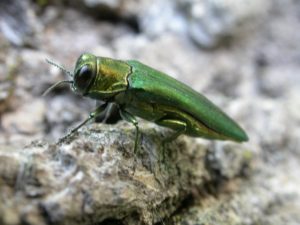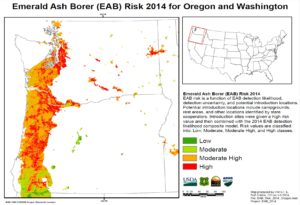I blogged about APHIS’ proposal to stop regulating movement of objects that can transport the emerald ash borer on 28 September. At that time, I and the Center for Invasive Species Prevention were undecided. Now we have taken a firm position: We are sympathetic to the situation in which APHIS finds itself and are disappointed that APHIS’ efforts against EAB have not been as successful as hoped. However, we believe the quarantine continues to serve a useful purpose in protecting North America’s ash (and through the firewood regulatory effort, other resources) and that the analysis APHIS provides does not justify the proposed termination of the regulatory program. Making this regulatory change, based on absent and questionable scientific data, would set a terrible precedent.
Problems Arising from Poorly Substantiated Proposal
Here I provide some additional information on points I made in the blog in September.
1) The APHIS documents are completely unbalanced. They provide no analysis of the economic or environmental impact of the regulatory changes that will allow the pest to spread more rapidly to the large areas of the country that are not yet infested.
The proposal concedes that emerald ash borer currently is known to occupy only about one quarter of the range of native Fraxinus species within the conterminous United States. As the Regulatory Flexibility Analysis states, numerous sawmills, firewood dealers, nurseries, logging/lumber companies, pallet manufacturing companies, and other establishments operate in these un-infested areas. The analysis makes no mention of the costs to millions of homeowners and property owners, thousands of municipal governments, etc., of removing and replacing ash trees on their properties that are killed by the ash borer as it spreads into new areas. The “analysis” makes no attempt to quantify impacts on any of these entities.
Examples of ash populations currently free of EAB include:
- In North Dakota, 84% of the forest land area is dominated by hardwood forest types; one of the three major forest-type groups is elm/ash/cottonwood. Ash represent 38% of urban forest trees (Nowak, Hoehn, Crane, Bodine.)
- In California, velvet ash (Fraxinus velutina) comprises 3.1% of the state’s street tree population (McPherson et al.). Because ash are large relative to other street trees, they provide about double the proportion of leaf cover (and associated environmental services) than the number of trees (Nowak, Hoehn, Crane, Weller, and Davila).
- Portland, Oregon: ash represented 4% of urban trees (Portland Parks).
No mention is made of the additional range of Fraxinus species in Canada and Mexico that will be put at greater risk of invasion as the beetle spreads in the United States.
2) The proposal to rely on biocontrol to control EAB in the future lacks any scientific analysis of either the current biocontrol program’s effects or other possible program components.
APHIS is apparently relying on the conclusion by Duan et al. 2018 – based on models rather than field research findings – that larval and egg parasitism at about 60% would lead to a net population growth rate of EAB at a rate below replacement, therefore rapidly reducing EAB populations when such parasitism rates are accompanied by moderate to high levels of host plant resistance. If heavy woodpecker predation can be relied upon, a parasitism rate on EAB larvae of about 35% would be sufficient to achieve a similar reduction in the EAB population growth, even with limited levels of host resistance or tolerance.
However, scientific publications reviewing the impacts of the decade-old EAB biocontrol program present a mixed picture.
Our reading of several published studies indicate that two biocontrol agents (Oobius agrili and Tetrastichus planipennisi) appear to have established and spread in the northern reaches of the EAB’s U.S. range and southern Canada. At least some ash species appear to be regenerating well in some of those areas. However, it is too early to determine whether a third biocontrol agent (Spathius galinae) can protect the all-important remaining large trees, which have thicker bark. It is also too early to determine whether a different biocontrol agent (Spathius agrili) will have an impact on ash survival and regeneration in the middle latitudes (south of the 40th parallel).
APHIS does not discuss current or planned future efforts to seek and test biocontrol agents more likely to thrive in the South and West – to which EAB will spread. It is hoped – but not yet proved – that S. agrili will be more effective south of the 40th parallel. The article said nothing about possible agents that might be effective farther south or especially in the West.
Some scientists question the probable efficacy of biocontrol. For example, Showalter et al. note that “Despite the presence of a full complement of coevolved natural enemies in Asia, EAB has caused high mortality of North American ash species planted there … Biological control is best applied to systems in which the hosts can at least partially resist or tolerate non-native PIP [phytophagous insects and phytopathogens] attack, especially if negative density-dependent responses of natural enemies are slow relative to how long it takes the non-native PIP to kill trees.” Even Duan et al. 2018 agree that Asian ash species are more resistant (although they emphasize the large impact of natural enemies in Asia).
The scientific literature indicates that the impacts of egg parasitoid O. agrili remain uncertain (Abell et al.).
Duan et al. 2018 list and provide brief evaluations of nine possible biocontrol agents:
- 2: status not revealed (Sclerodermus pupariae, Atanycolus nigriventris)
- 2: disappointing efficacy to date (Spathius agrili, Oobius agrili)
- 1: apparently efficacious in some geographies in smaller trees only (Tetrastichus planipennisi)
- 1: promising in northern parts of EAB range but too early to evaluate (Spathius galinae)
- 2: considered to have too broad a host range to be released (Tenerus, Xenoglena quadrisignata)
- 1: release delayed pending further study (Oobius primorskyensis)
Even the impact of the most promising agent, Tetrastichus planipennisi, is not altogether clear. Duan et al. 2018 cite their life table analyses as indicating that T. planipennisi has contributed significantly to reducing net EAB population growth rates. They note a 90% reduction in EAB larval density. However, they say that this decline might be attributed in part to either the impact of the parasitoid or the general collapse of EAB populations following widespread mortality of overstory ash. (emphasis added)
3) Neither the proposal nor the supplementary materials provides any information about the current allocation of available funding among APHIS’ program components or how those allocations will change if the proposal is adopted.
For example, APHIS has set a goal of releasing biocontrol agents in every county with a known EAB infestation where the agent populations can be sustained. The proposal states that, by the end of the 2017 field season, parasitoids had been released in 27 of 32 states and 2 of 3 provinces in which EAB is present (Duan et al. 2018). APHIS does not explain how the current funding allocation hampers achieving the stated goal.
4) The proposal and accompanying regulatory flexibility analysis provide no information about whether APHIS will expand efforts supporting such other EAB impact minimization strategies as breeding trees resistant to emerald ash borer attack.
Even biocontrol practitioners (e.g., Duan et al. 2018 ) point to the importance of including breeding of resistant trees in the future efforts.
5) The proposal offers only vague promises about continuing federal efforts to minimize the risk that human transport of firewood will facilitate spread of the emerald ash borer or other tree pests.
Unfortunately, the impact of an outreach message depends heavily on having a simple, straightforward, unified message. Absent the EAB quarantine, which provides a nation-wide standard for firewood treatment, the “Don’t Move Firewood” campaign will be confronted by the task of trying to explain diverse messages and policies/rules issued by various states, counties, provinces, and managers of parks and other public lands. Hampered by this welter of messages, even the well-managed DMF campaign will struggle to persuade the public to help curtail spread via this pathway.
APHIS today published a set of “frequently asked questions” that address some of the issues raised in this blog. Go here to read the answers.
The Center for Invasive Species Prevention urges all who care about protecting North America’s native flora from non-native insects and diseases to submit comments on this proposed rule before the deadline on 19 November. This can be done by visiting here http://www.regulations.gov/#!docketDetail;D=APHIS-2017-0056.
Posted by Faith Campbell
We welcome comments that supplement or correct factual information, suggest new approaches, or promote thoughtful consideration. We post comments that disagree with us — but not those we judge to be not civil or inflammatory.
SOURCES
Abell, K.J., L.S. Bauer, J.J. Duan, R. Van Driesche. 2014. Long-term monitoring of the introduced emerald ash borer (Coleoptera: Buprestidae) egg parasitoid, Oobius agrili (Hymenoptera: Encyrtidae), in MI, USA and evaluation of a newly developed monitoring Technique. Biological Control 79 (2014) 36–42
Duan, J.J., L.S. Bauer, R.G. van Driesche, and J.R. Gould. 2018. Progress & Challenges of Protecting North American Ash Trees from the emerald ash borer Using Biological Control. Forests 2018, 9, 142; doi:10.3390/f9030142
McPherson, G., N. van Doorn, J. de Goedec. 2016. Structure, function and value of street trees in California, USA. USDA Forest Service, Pacific Southwest Research Station Urban Forestry and Urban Greening 17 2016 (104-115)
Nowak, D.J., R.E. Hoehn III, D.E. Crane, A.R. Bodine. Assessing Urban Forest Effects and Values of the Great Plains: Kansas, Nebraska, North Dakota, South Dakota. USDA Forest Service Northern Research Station Resource Bulletin NRS-71
Nowak, D.J., R.E. Hoehn III, D.E. Crane, L. Weller, A. Davila. Assessing Urban Forest Effects and Values: Los Angeles’ Urban Forest. USDA Forest Service Northern Research Station Resource Bulletin NRS-47
Portland Parks and Recreation Street Tree Inventory Findings 2015. www.portlandoregon.gov/parks/treeinventory
Showalter, D.N., K.F. Raffa, R.A. Sniezko, D.A. Herms, A.M. Liebhold, J.A. Smith, P. Bonello. 2018. Strategic Development of Tree Resistance Against Forest Pathogen and Insect Invasions in Defense-Free Space. Frontiers in Ecology & Evolution


There are lots of websites about invasive species. Google your topic – e.g., forest pests or a particular species (emerald ash borer). I would use government websites – USDA (APHIS and Forest Service), state sites … there is an “EAB university” that hosts lots of information. Be wary of commercial pesticide companies’ sites – some are pushing product (although there are pesticides approved for managing EAB). Government websites do tend to push an overly optimistic line, in my view. But their information is accurate.
Excellent read, I just passed this onto a colleague who was doing some research on that. And he actually bought me lunch since I found it for him smile Therefore let me rephrase that: Thanks for lunch!